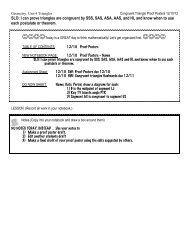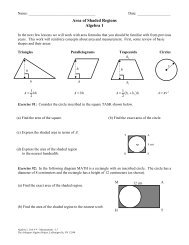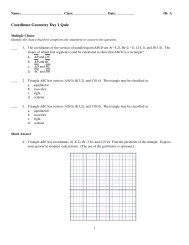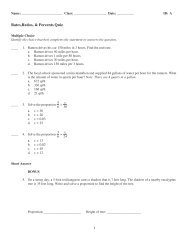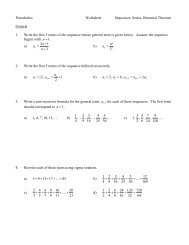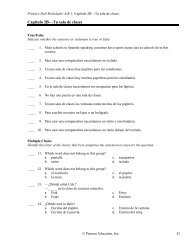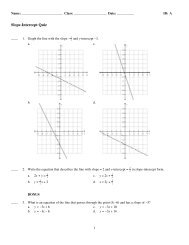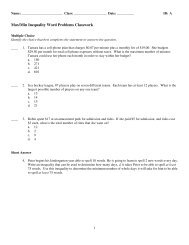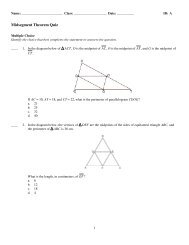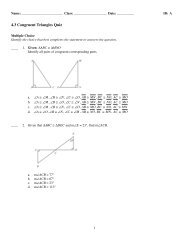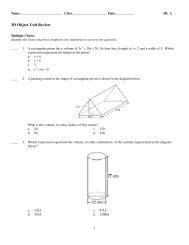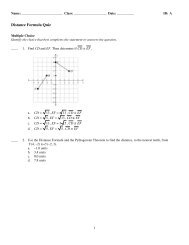RCSD Strategic Plan - Rochester City School District
RCSD Strategic Plan - Rochester City School District
RCSD Strategic Plan - Rochester City School District
- No tags were found...
You also want an ePaper? Increase the reach of your titles
YUMPU automatically turns print PDFs into web optimized ePapers that Google loves.
Every Child is a Work of ArtCreate a Masterpiece.<strong>Rochester</strong> <strong>City</strong> <strong>School</strong> <strong>District</strong> • <strong>Strategic</strong> <strong>Plan</strong> 2008-2013
Table of ContentsLetter from the Board President and Superintendent........................................................................................................................3Introduction........................................................................................................................................................................................4Our Mission and Vision..................................................................................................................................................................4Our Core Values: Achievement, Equity, and Accountability...........................................................................................................4What this <strong>Plan</strong> Means to You.............................................................................................................................................................5Achieving Our Vision..........................................................................................................................................................................6Core Strategies..................................................................................................................................................................................6Change Is Possible: Year One............................................................................................................................................................9<strong>Strategic</strong> Goals Overview................................................................................................................................................................10Key Themes across the Strategies and Goals.................................................................................................................................11Performance Measures....................................................................................................................................................................12<strong>Strategic</strong> Goals................................................................................................................................................................................16GOAL 1: Ensure that each of our students is academically prepared to succeed in college, life, and the global economy.......16GOAL 2: Create safe, engaging, and nurturing school environments that enable student success...........................................19GOAL 3: Recruit, develop, and retain highly effective, diverse people dedicated to student success.......................................20GOAL 4: Use world-class operational standards and practices to continuously improve how we support student success....21GOAL 5: Create a culture in which we hold ourselves accountable for student success...........................................................22Timeline............................................................................................................................................................................................24Implementing This <strong>Plan</strong>....................................................................................................................................................................322
From the Board of Education President and SuperintendentDecember 2009Dear <strong>Rochester</strong> Community Members,Our strategic plan begins with our belief that every child, every child,can succeed.Malik EvansJEAN-CLAUDE BRIZARDEmboldened by this belief, we are driven to face our challenges, embracethe changes we must make to our culture and practices, and hold ourselvesaccountable for the success of every student. Together, we canachieve our vision to create a masterpiece of every child, each a work ofart, who we have the profound privilege and profound responsibility toeducate and to prepare for success in college, work, and life.This plan is the product of the work we began nearly two years ago toimprove student success. It is the result of our efforts as a district and asa community. The plan was developed under the leadership of the Superintendentand his senior administrative team, with support from theBoard of Education, and shaped through conversations with principals,teachers, parents, students, and others. The community played a criticaland integral role in its development. Through your feedback on our onlinestrategic plan survey along with your participation in meetings, focusgroups, and public forums, you directly shaped this 5-year strategic plan.We look forward to continuing and strengthening our partnership with youin support of our students.The strategic plan provides a roadmap for our work beginning with ouraccomplishments in the 2008-2009 school year and continuing through2012-2013. It details the changes we must make at the district, school,and classroom level to ensure student success. Because our core workof teaching and learning takes place in the school and classroom, this iswhere we will focus our efforts, resources, and impact over the next fiveyears. Our entire community, however, plays a role in helping us reach ourgoals.The activities and timelines in this plan may change as we move forwardand face new challenges. What will not change is our goal to ensure thesuccess of every student.Sincerely,Malik EvansBoard of Education PresidentJean-Claude BrizardSuperintendent of <strong>School</strong>s3
IntroductionOur VisionEvery child is a work of art. Create a masterpiece.At the core of our strategic plan is the belief that our work is about everychild. Every child brings a wealth of talent and potential to us. We mustembrace that talent and potential and equip every student with an educationthat draws forth the masterpiece that lies within each of them.Our MissionThe mission of the <strong>Rochester</strong> <strong>City</strong> <strong>School</strong> <strong>District</strong> is to provide a qualityeducation that ensures our students graduate with the skills to be successfulin the global economy.Our Core Values: Achievement, Equity, and AccountabilityOur core values are based on our belief that every child can succeed.Every child can become a masterpiece.Achievement - Improving student achievement through a laser-like focuson teaching and learning with an emphasis on resultsEquity - Distributing resources equitably based on the needs of schoolsand studentsAccountability - Using data to ensure that we hold adults accountable forthe success of all students4
What This <strong>Plan</strong> Means to YouThis strategic plan is about ensuringthat every child succeeds. Ourentire community has a role to playin making it happen.If you are a student, you can…• Have high expectations for yourself,learn what you need to do togrow academically and socially atschool, and commit to doing that.• Seek support from your principals,teachers, guidance counselors,and school staff on theacademic and social issues youface.• Expect a high level of respectfrom your teachers and schools.• Expect and request high-qualitycustomer service from the <strong>Rochester</strong><strong>City</strong> <strong>School</strong> <strong>District</strong> whenyou need information or help.• Communicate to the <strong>Rochester</strong><strong>City</strong> <strong>School</strong> <strong>District</strong>, through yourschool, student leadership, anddirectly, when you need us to dosomething differently or better.If you are a parent, you can…• Talk with school staff about yourchild’s education and how youcan support his or her learning.• Emphasize at home the highstandards the <strong>Rochester</strong> <strong>City</strong><strong>School</strong> <strong>District</strong> sets for every oneof its students.• Expect to be treated with respectand a high level of customerservice when interacting with anypart of the district.• Expect and request a range ofhigh-quality school and programchoices that reflect the diverseneeds and interests of your child.• Expect and request access toinformation about your child’sschool and your child’s performanceat school.If you are a community member,you can…• Emphasize in the community thehigh standards <strong>Rochester</strong> sets forevery one of its students.• Consider ways in which you canpartner with the <strong>Rochester</strong> <strong>City</strong><strong>School</strong> <strong>District</strong> to further studentsuccess.• Support the dissemination ofaccurate information about ourschools and students in the community.• Hold us accountable for supportingstudent success by reviewingour strategic plan progressreports and questioning us aboutour performance.• Hold us accountable for how weuse taxpayer dollars.If you are a <strong>Rochester</strong> <strong>City</strong><strong>School</strong> <strong>District</strong> school administrator,teacher, or staff member,you can…• Hold every student to high standardsin your school or classroom.• Empower students and familieswith knowledge of what studentsmust know and be able to do.• Hold yourselves accountable foradding to what every studentknows and can do, every day.• Collaborate with your fellowadministrators, teachers, andstaff to determine how to improveteaching and learning in yourschool.• Be flexible and willing to adjustteaching to better accommodatediverse student learning needs.• Expect and request a high levelof professionalism, courtesy andhigh-quality professional developmentsupport from centraladministration.If you are a <strong>Rochester</strong> <strong>City</strong><strong>School</strong> <strong>District</strong> staff member whodoes not work in a school, youcan…• Emphasize in your daily work thedistrict’s high standards for everystudent.• Discuss with your supervisor andcolleagues on how you can bestcontribute to student success.• Maximize the time and effort youspend on supporting student andschool success.• Be flexible and willing to adjust tonew and improved ways of doingwork centered on students andschools.• Expect and request a high levelof collegiality, respect, and recognitionfor your contribution to thedistrict.5
STUDENT SUCCESSFOCUSCENTRALOFFICEH AGILEH FLEXIBLEH RESPONSIVEH EMPOWERING6
Achieving Our VisionIn January of 2008, guided by our core values of achievement, equity, and accountability, then-new SuperintendentBrizard and members of his leadership team set out on an extensive listening and learning tour thatinvolved meeting with hundreds of community members—students, parents, principals, teachers, districtstaff, and community partners. Your observations and insights combined with a detailed analysis of districtperformance helped to establish a clear picture of our current state and challenges to improving studentsuccess over the next five years.What ultimately emerged was an ambitious agenda for change. At the heart of this agenda are two corestrategies that will continue to focus and direct our efforts through 2013:Core StrategiesStrategy 1: Proactively manage and supportperformance to empower schoolsOur core work as a district is teaching and learning.Since teaching and learning take place in schools,schools must be the primary focus of our efforts andresources. Central administration will manage and supportschool performance to ensure student success.<strong>School</strong>s, in turn, will be held accountable for theirperformance.Based on their performance and capacity, schools willreceive different levels of support and flexibility.Strategy 2: Create an organization and culturethat is agile, flexible, and responsive toschools and studentsWe will be a lean and efficient organization that makesit easy for schools and students to get the supportthey need. We will work toward continuous improvementand change our culture toward one in whichsupport for schools and students is everyone’s focus.If we all acknowledge that every student can succeed,they will. If we are motivated by the belief that everystudent is a work of art and can become a masterpiece,we can motivate them to believe this too.Strong performers with high capacity will be empoweredwith the flexibility to make certain decisions,requesting support from central administration on anas-needed basis. These schools will be called Autonomous<strong>School</strong>s. <strong>School</strong>s that do not perform well willreceive less flexibility and receive proactive, targetedsupport to improve their performance. These schoolswill be called Dream <strong>School</strong>s, a concept we launchedin 2008-09. Dream <strong>School</strong>s and other schools thatfail to improve over time will be phased out or closed.<strong>School</strong> leaders and teachers will both play a criticalrole in this new structure.7
SNAPSHOT OF OUR DISTRICT TODAYWe are far from where we need to be to truly prepareeach of our students for success in college,work, and life.• Nearly half of our students do not graduate highschool in 4 years.• Nearly half of our students do not graduate highschool in 5 years.• We have significant achievement gaps that impactparticular groups of students. For example, gaps ingraduation rates are as follows:- African American and White students: 4 percentagepoints- Latino and White students: 9 percentage points- English Language Learners (ELL) and non-ELLs: 19percentage points- Students with Disabilities and General Educationstudents: 33 percentage pointsWHAT THIS MEANS TODAY AND TOMORROWIf we don’t change for the better, we are effectivelysaying to ourselves, our country, and the world that itis okay to have lower expectations for minorities andlower-income students.If we don’t equip every student for college, work, and life,we are saying that it is okay for our children to be worseoff than we are. We are contributing to a future in whichour children will grow up to:• Suffer from health issues as much or more than we do• Struggle to find employment and be very likely to endup in poverty• Earn hundreds of thousands of dollars less in their lifetimethan their better educated counterparts• Be more likely to engage in criminal behavior that willmake our city and county a less safe and desirableplace to live• Lack the ability to take full advantage of their rights andfreedoms as democratic citizens• Be ill-equipped to understand and change the worldaround them for the betterWhere we are as a city<strong>Rochester</strong> faces mounting challenges, from povertyto a declining population to health issues.• <strong>Rochester</strong> ranked 11 th in the nation for child poverty.36.9% of children under the age of 18 are inpoverty and that number increases to 37.2% forchildren under the age of 5.• We have the highest rate of poverty among NYSBig 5 districts; 50% of our schools are at 90% povertyor higher.• Between 2000 and 2006, the population of <strong>Rochester</strong>declined by 5.3%. Enrollment in our schooldistrict has continued to shrink over the past tenyears.• In the 2000s, 14-15% of incoming <strong>RCSD</strong> Pre-K andK students were hospitalized in a Neonatal IntensiveCare Unit (NICU) at birth. That figure increasedto 19.7% in 2007-08. This represents a changefrom every 1 in 7 to every 1 in 5 children.• In 2007-08, over 15% of incoming Pre-K studentshad a parent who was incarcerated.• In that same year, over 27% of incoming Pre-K studentshad experienced the death of a close familymember.• The estimated 2007 median household income in<strong>Rochester</strong> was $29,329, over 45% lower than theNYS median of $53,448.How will better educating our studentshelp our city today and tomorrow?If we drastically improve the education we provide toour students, we will:• Give the families who will leave us for jobs and a bettereducation in the suburbs a reason to stay• Attract new families, increase our city’s population, andincrease our tax base• Improve the quality of our workforce and ability to attractbusinesses that will create jobs• Reduce the rate of poverty• Reduce the scope and severity of health issues we face• Improve the safety of our city, making it a more pleasantplace to live, work, and go to school• Spend our taxes on public health and education insteadof incarceration• Improve the health, well-being, and academic readinessof our next generation of incoming students• Fulfill a moral, civic, and economic duty to improveourselves, our children, and our society• Prove that an urban education that provides every childwith the opportunity to excel, regardless of race/ethnicity,disability, language proficiency or income level, canwork.8
Change Is Possible: Year OneWhile our challenges may seem daunting, the progress and growth of our district demonstrate that positive changeis very possible.We hit the ground running in 2008-09, year one ofthe 5-year strategic plan, and made the followingkey changes:• We completed the first phase of a district-widereorganization, devolving people and other resourcesfrom the central office to schools. That set us on thepath to begin concentrating our resources at schoolsand make our organization more agile and responsiveto school needs.• Through the Dream <strong>School</strong>s Initiative and our newOffice of <strong>School</strong> Innovation, we began to proactivelysupport and manage school performance to provideour students with high-quality, competitive secondaryschool options.• We eliminated the practice of sending suspendedstudents home with the goal of maximizing time forstudent learning, re-focusing our organizational approachto school safety around student needs andacademic rigor.• We began the development and rollout of the <strong>Rochester</strong>Curriculum, empowering schools, students,and families with a common understanding of ourhigh expectations of what students should know andbe able to do in each grade.• Through the first phase of an overhaul that increasedtransparency in our district budgeting process, weimproved our understanding of how we can betterfocus our fiscal resources in service to our students.As the 2008-09 school year drew to a close, we reflectedon the results of our changes, the progresswe made, and the work that remains:• Four-year graduation rates for students who started9th Grade in 2002, 2003, and 2004 continued toincrease. The 2004 Total Cohort Graduation Rate(2008 graduates) is 52% (1,153 of 2,220).• Achievement in Grades 3-8 on New York StateMath Assessment continued to improve overall. Thepercent meeting NYS standards went from 55% in2007-08 to 63% in 2008-09, an 8 percentage pointincrease.• Achievement in Grades 3-8 on New York State EnglishLanguage Arts (ELA) Assessment continued toimprove overall. The percent meeting NYS standardswent from 47% in 2007-08 to 56% in 2008-09, a 9percentage point increase.• The graduation rate for our former English LanguageLearners (ELL) (76% graduation rate) surpasses bothNon-ELL (52%) and ELL (33%) students by 23 and43 percentage points respectively.• The significantly low graduation rate for our Studentswith Disabilities at 24% supports our plan to overhaulSpecial Education.• LEAN/6-Sigma training was conducted for theSuperintendent’s cabinet, eight Administration leadersand 20 additional personnel.• $1.4M in safety and security value (cameras, GPSand bus attendants) was added to our student transportationservice through our new contract.• Regulations for Intervention and Discipline were developed;suspensions dropped 32% and disruptiveincidents dropped 40%.• A reader-friendly budget book to improve the transparencyof our fiscal operations was developed.• Our <strong>School</strong> Food Services operation’s financial performanceimproved by $586,000 (4%).Public InputAs we pushed our agenda for change forward, we alsocontinued to solicit community input.Over 1,300 members of the <strong>Rochester</strong> community—student, parents, district staff, and community partners—shapedour plan through participation in focusgroups and by responding to our online <strong>Strategic</strong> <strong>Plan</strong>survey.We cannot underscore enough the importance ofcommunity engagement with the district. It is simplycritical to student success. Given the profound impactthat the school district has on the community and viceversa, we cannot operate in isolation from each other;we must collaborate as partners. The community’scritical insights and recommendations are integratedthroughout this plan. We will continue to engage thecommunity to support us and hold us accountable formeeting our goals for student success through 2013.9
<strong>Strategic</strong> Goals OverviewTo clearly define our path and frame our agenda, we have establishedfive goals:GOAL 1 We will ensure that each of our students is academicallyprepared to succeed in college, life, andthe global economy.GOAL 2 We will create safe, engaging, and nurturingschool environments that enable student success.GOAL 3 We will recruit, develop, and retain highly effective,diverse people dedicated to student success.GOAL 4 We will use world-class operational standardsand practices to continuously improve how wesupport student successGOAL 5 We will create a culture in which we hold ourselvesaccountable for student successOur actions to accomplish these goals will be focused by our two core strategies:STRATEGY 1STRATEGY 2Proactively supporting and managing performance to empower schools, andCreating an organization that is agile, flexible, and responsive to school needs.10
Key Themes across the Strategies and GoalsContinuous improvement refers to makingsmall improvements in processes that result inincreased quality of products and services.“Recognition, Intervention, and Adjustment” is aneducational practice based on the idea of continuousimprovement. The idea behind this practice isfairly simple:Recognition: Take stock of the results of youractions by looking at data to assess the impact ofyour practices or actions. Keep in mind the goalsyou’re working towards.Intervention: Based on your findings about whatis and isn’t working and keeping in mind what yourgoals are, select or develop an intervention based onprior evidence, research, or best practice.Adjustment: Try the intervention. Check to seeif it is changing results in a way that will help youachieve your goals. If so, determine how to sustainor accelerate your progress. If not, go back to “Recognition”and repeat the cycle.The use of data is essential to this cycle ofcontinuous improvement. You can’t simply rely onobservations or your gut. You need to see what thedata says. That’s the “Recognize” step. You thenneed to use the data to help you determine whatyou’ll do differently and how. That’s the “Intervene”step. Finally, once you make the change by puttingthe intervention into practice, you’ll have to monitoryour data again to see if the change is working. Thathappens after you take the step to “Adjust.”These themes pervade the plan and our work. Theywill be fundamental to helping us change our cultureto better support and drive student success.11
Performance MeasuresWe have set performance targets for each of our goals. As we did in year one, we will continue to monitor ourperformance data to assess our progress toward achieving our goals. We will become more aggressive about ouruse of data and about reporting on our progress. (See the “Monitoring Implementation” section of the plan.) Whenthe data demonstrate we are off track, we will intervene and adjust our practices. When it demonstrates we’re ontrack, we will determine how to sustain or accelerate our progress.Note: Some of our performance measures indicate “TBD” rather than actual target metrics. In some cases, this isbecause we have not yet developed the metrics; in others, it is because a sub-strategy/initiative has not yet begun and thusdoes not yet have baseline data. As we move forward, we will publish the additional measures and metrics as part of ourstrategic plan progress reports. (NA=Not available.)GOAL 1 We will ensure that each of our students is academically prepared to succeed in college, life, and theglobal economy.OBJECTIVE I: Ensure Academic Rigor for Every StudentOBJECTIVE II: Differentiate Student Supports to Meet the Needs of Every StudentOBJECTIVE III: Focus on College and Career ReadinessOBJECTIVE IV: Create an Innovative Portfolio of High Quality Choices for FamiliesGraduation/College & Career Readiness Baseline Annual TargetsFor Cohort Students Graduating in: 2008 2009 2010 2011 2012 2013Percent of Cohort Students: Cohort 2004 Cohort 2005 Cohort 2006 Cohort 2007 Cohort 2008 Cohort 2009Completing High <strong>School</strong> within 4 years 52% 46%* 52% 59% 65% 75%Number of Regents Required to Pass none two three four five fiveGraduation with Regents Diploma 21% 20% 30% 49% 55% 60%Graduation with Advanced Regents Diploma 7% 8% 9% 10% 11% 15%Graduation with Local Diploma 24% 20% 14% 7% 0% 0%Average PSAT Scores (Out of 240) 115 103 TBD TBD TBD TBDAverage SAT Scores (Out of 2400) 1228 1216 TBD TBD TBD TBDCLOSE UP: GRADUATION RATE Completing High <strong>School</strong> within 4 Years7552 % 59 % 65 %52 % %46 %*Graduation Year 2008 2009 2010 2011 2012 201312*Projected decline due to phasing out of NYS local diploma. Phase-out will be completed in 2012.
Early Childhood Education, from Pre-K throughgrade 2, provides students with strong foundationsthat are critical to student success. We willcontinue to deliver high-quality Pre-K instructionthrough our nationally recognized program and continueto use data to inform program improvements.We also seek to expand access to Early Childhoodand are seeking policy and funding solutions at thestate level. We will ensure there is strong alignmentin curriculum and assessments from Pre-K throughgrade 2 to ensure that the benefits of Pre-K educationcarry through to elementary school and beyond.Physical Education is intimately linked to academicachievement among students. Research continuesto indicate that physically fit students outperformtheir less healthy counterparts. 7 Further, we know thatmany of our students suffer from a range of healthissues common to children from urban areas. We willfocus and align our physical education, school food,nutrition, and student health and wellness efforts andpartnerships to better prepare our students to learnand to equip them to make healthier choices.Arts Education is critical to ensuring we developthe whole child. Through a greater central focus onan aligned yet differentiated Arts curriculum, we willprovide students with higher quality arts instructionthat is better reflective of their interests and learningneeds.Response to Intervention (RtI) is used to help everystudent who is struggling to learn and succeed in theclassroom by adjusting instruction to accommodatehis or her specific learning needs. This approachaddresses student skill or performance deficits earlyand quickly. Each student is provided with the timeand supports they need to improve. RtI acknowledgesthat although every child may be different, highexpectations and quick, aligned responses can keep astudent on track to meet or exceed expectations. Withthe use of RtI, we expect to see a decline in SpecialEducation classifications and earlier improvements inlanguage acquisition and proficiency among EnglishLanguage Learners.Targeted Supports will prevent student academicregression and accelerate student learning during keytransition periods such as summers, after school, andfrom grades 7 to 8 and 8 to 9. We know that somestudents struggle during transition and that more timefor instruction can help keep them on track. Studentswho are already on track can significantly acceleratetheir learning if offered additional time and support.We will provide summer school, after school, andother extended learning opportunities to as manystudents as possible.OBJECTIVE II: Differentiate Student Supports toMeet the Needs of Every StudentWhile every student is a work of art, and should beheld to the same high expectations for success,what every student needs to become a masterpiecemay vary. With a shared culture of high expectations,schools will recognize and embrace the differences inhow our students learn. They will use data to tailor thetime, resources and supports every student requiresfor academic mastery toward college readiness.Use of Data: Research shows that the use of datais common to the highest performing districts in thecountry. Central office will support schools in thefrequent use of data to inform instruction by providingthem with a comprehensive set of tools and trainingto use the tools. <strong>School</strong>s in turn will use the data toexamine the performance of every student, not simplyaverages across students, to manage and deliver effectiveinstruction.7NYC Department of Health and Mental Hygiene Press Release: http://www.nyc.gov/html/doh/html/pr2009/pr047-09.shtml17
OBJECTIVE III: Focus on College and Career ReadinessCollege-readiness isn’t about anticipating that all students will attendcollege; it’s about preparing them to access a full range of options aftergraduation. It’s not about restricting their choices; it’s about broadeningthem. This is reinforced by national and state recognition of the fact thatthe knowledge and skills required for career readiness are increasingly thesame as those required for college readiness, especially in the areas ofMath and English. 8 Regardless of the path they choose after graduation,every student must leave us college-ready.Empowering students with both knowledge and experiences that willprepare them for college is critical. We will clarify the indicators andperformance measures we monitor to know that our students are readyfor college. We will create a clear college counseling curriculum, to beimplemented by our guidance counselors, that families and students haveaccess to online. And we will ensure that we develop and sustain stronghigher education partnerships to expose and educate our students aboutcollege from an early age.Empowering students with both knowledge and experiences that willprepare them for careers is critical. We will strengthen the rigor of ourcareer and technical education offerings. We will partner with businessesto broaden students’ awareness of the range of career opportunities availableto them. We will provide students with meaningful career developmentand mentorship opportunities early in their education, giving themextra time to think about their future careers.OBJECTIVE IV: Create an Innovative Portfolio of High-Quality Choicesfor Families“Work towardsaccountability at all levelsfrom the top down.”-Public input from the strategic plan survey8American Diploma Project, “Making College and CareerReadiness the Central Drivers of an Assessment System.”http://www.ccsso.org/content/PDFs/NCSA09_191_MGandal.pdfWe must view our schools as a system or “portfolio,” not as isolatedplaces with no relationship to one another. This is especially true given thehigh mobility rate of students in our district. Taken as a whole, our schoolsmust offer enough high-quality program choices that reflect the diversetalents, needs, and interests of every one of our students. Without highqualitychoices, families will continue to leave us for other districts.To continuously improve the quality and rigor of our portfolio ofschools, we must open new schools fueled by innovative ideas thatarea also grounded in evidence and research. We must redesign existingschools by either expanding or shrinking them so they can better servestudents. We must support schools, through the Dream <strong>School</strong>s model,to improve their performance. Finally, if schools continue to fail, we mustphase them out or close them. This requires will, commitment, and motivation.It is not easy to do, but it is necessary; we cannot be true to ourvision without replacing failing schools with schools that work.Re-tooling our choice and enrollment process is directly related to improvingour portfolio of school choices. As we change the number, quality,and focus of our schools to better address the needs of every student,we must make sure that families have equitable access to these new andhigher quality choices.18
GOAL 2: We will create safe, engaging, and nurturing school environments that enable student success.OBJECTIVE I: Effective Safety Systems and PracticesOverhauling our student discipline policies and practices toreduce disruptions to teaching and learning was a primary focus forus in Year One. We abolished the practice of sending suspended studentshome, drastically reducing the number of instructional hourslost for these students. We established In-<strong>School</strong> Suspensions andwill continue to improve the supports we provide to schools. We alsohave clarified and developed standards for school discipline and willmanage and support schools to use them. Finally, we will continueto partner with the RPD and use data to inform additional improvementsto our safety and discipline practices.A school security plan focused on clear and effective interventionis the next step. We need to delve further into evidence- andresearched-based practices to develop a system-wide security planthat allows us to practice Recognition, Intervention, and Adjustmentto prevent and address school safety and student discipline issuesearly. Once we develop the plan, we will roll it out with training andsupports for schools and hold them accountable.“Research and utilize thepractices of other successfuldistricts and use the honestfeedback provided to you bystudents, parents, staff, etc.”-Public input from the strategic plan surveyOBJECTIVE II: Support the Whole Child through a SystemsApproach to <strong>School</strong> Culture and ClimateA Youth Development Framework that provides a comprehensive,systematic approach to addressing student health, attendance,behavior, adult connections, and teaching and learning is being finalizedand piloted in a small group of schools. The framework is ambitiousand intended to change school culture and practice. It focuseson prevention, early intervention, and intensive intervention.The framework will reinforce the use of Response to Intervention (RtI)and the district’s Regulations of Intervention & Discipline, and willalso pilot the use of Positive Behavioral Intervention and Supportsin a broader group of schools. The result of the pilot will be usedto inform improvements to the framework before schools adopt itdistrictwide and develop their own Youth Development plans basedon the framework. Other key related initiatives involve clarifying anddistinguishing the role of social workers from guidance counselors.Guidance counselors will primarily focus on student academics andcollege readiness. Social workers will play an integral role in youthdevelopment.19
GOAL 3: We will recruit, develop, and retain highly effective, diverse people dedicated to student success.OBJECTIVE I: Develop and Support Highly Effective <strong>School</strong> LeadersWe are establishing a comprehensive system to recruit and equip schoolleaders to assume increased autonomy and accountability for school andstudent performance. We will continue to recruit highly effective schoolleaders locally and nationally to ensure we have a strong pipeline of talent.Existing and aspiring school leaders will be developed through the <strong>Rochester</strong>Leadership Academy (RLA), an innovative professional developmentinstitute created in partnership with St. John Fisher College and theWallace Foundation through the New York State Education Department’sCohesive Leadership initiative. RLA’s purpose is to strengthen our existingleaders and build their capacity to assume greater autonomy and accountability.Hold school leaders accountable and organize central office supportsaround their needs. This is a critical step we’re taking to manageand support school performance and prepare school leaders to transitionto the Autonomous and Dream <strong>School</strong>s structure. Over the course of ourmulti-year transition to the new structure, our Chiefs of <strong>School</strong>s will continueto supervise principals and serve as liaisons between principals andcentral office to coordinate the supports they need to succeed.“Highly qualifiedadults, given adequateresources and safeschool environments, canproduce superb resultswith children.”-Public input from the strategic plan surveyExamine, strengthen, and align principal evaluation, tenure, andcompensation structures. In high-performing organizations, peopleknow what they are expected to do, are evaluated on how well they do it,and are given rewards or consequences based on their performance. TheChiefs of <strong>School</strong>s will conduct rigorous evaluations of principals, groundedin data and their expert observation of principals over the school year.Principals will be held accountable for performance. <strong>School</strong>s that haveweaker performance and school leader capacity will receive fewer freedoms,while those with stronger performance and more effective schoolleaders will get more. The school district will also continue to explore innovationsin school leader compensation and performance management.OBJECTIVE II: Develop and Support Highly Effective TeachersThe district will continue to recruit and support talented and effective newteachers. We use the term “highly effective,” not “highly qualified.” Efficacygoes beyond having the right certification or qualification to teach astudent. It extends to commitment, capacity, and a belief in every student.We will continue to recruit diverse, effective teachers capable of providinghigh-quality instruction to every child. Our teachers will be committed toacknowledging the link between their practice and student outcomes andbe willing to adjust their practices based on what will move their studentsforward. Based on the high retention rates of teachers supported throughour nationally recognized Career in Teaching (CIT) Mentor program, we willcontinue to support first-year teachers through the program.20Equip teachers to deliver effective instruction to support student andschool performance. The district will manage and support instruction byproviding job-embedded professional development in using the <strong>Rochester</strong>Curriculum Framework. We will help also schools to embrace their role inour learning organization by supporting the establishment of professionallearning communities (PLCs) that center around the <strong>Rochester</strong> Curriculum
Framework. The PLCs will provide teachers with structures and supports so theycan focus on learning and the use of data to support learning, results, and workingcollaboratively to support effective instruction.Examine, strengthen, and align teacher evaluation, tenure, and compensationstructures. As with school leaders, teachers must be held accountable forstudent performance. In the entire school system, they have the most direct relationshipto and impact on students. <strong>School</strong> leaders will support and hold teachersaccountable for providing rigorous instruction for every student and for theiroverall performance. <strong>School</strong> leaders will conduct rigorous and timely evaluationsof teachers grounded in data and their expert observation of teachers over theschool year. The school district will also continue to explore innovations in teacher-distributedleadership, teacher compensation and performance management.GOAL 4: We will use world-class operational standards and practices to continuously improve how wesupport student successOBJECTIVE I: Create Learning Environments that Support Student SuccessImprove transportation safety and efficiency to reduce disruptions toinstruction. In making changes to our transportation system to achieve costsavings, we have remained focused on ensuring that students arrive at schoolsafely and on time so they are ready to start the academic day.Provide students with high-quality, age-appropriate food to promote healthand wellness. Student health and wellness are intimately tied to academicachievement. The level of satisfaction with our food service was low and costswere high; it was clear that we needed to change. Working in partnership withFinger Lakes Health Systems Agency, we will provide high-quality food in an efficientand effective manner that promotes student health and wellness.Modernize, maintain, and right-size our facilities portfolio to support studentlearning. Research shows that clean, safe, and well-maintained facilitiespromote student learning. They also promote a sense of pride in our communityand acknowledge the value we place on education in our community. Our workover the next five years involves continuing our work and partnership with theJoint <strong>School</strong> Construction Board to modernize, maintain, and right-size ourportfolio of schools.OBJECTIVE II: World-Class Standards of Efficiency and Customer ServiceOrganize central office (CO) around school and student needs. As weanalyzed our district in 2008, it was clear that our central office to student ratiowas larger than any of the other NYS Big 5 districts. That fact combined withthe strategies we developed to focus our agenda for change motivated us tosignificantly reorganize the central office in the fall of Year One. We will continueto focus and align our central structures and functions to school and studentneeds. This will likely continue to involve further reorganizations that reduce thesize of central office.Continuously improve district processes, procedures and systems to betterserve schools and students. As a learning organization, we must examineour systems and processes and identify areas for improvement. This applies toeverything from our Human Capital systems like PeopleSoft to food services totransportation. The goal is not to reinvent the wheel, but to rely on proven methodologiesto improve our service to schools and students.21
GOAL 5: We will create a culture in which we hold ourselves accountable for student success.OBJECTIVE I: Stakeholder Engagement and SatisfactionEngage parents as partners in the journey to student success. It’s notenough to say that parent engagement is a challenge; we must be creative.Through surveys, we will solicit creative ideas from parents directly.Further, we will continue to offer Parent University courses to help parentsfurther their own education and improve their ability to navigate the system,so they may help children to do the same.Hold ourselves accountable to parents and provide them with efficientcustomer service. We are responsible for clarifying what theirchildren are expected to learn and whether or not they are meeting theseexpectations. We are responsible for communicating timely and clearlyto allow parents to make the best choices on behalf of their children. Weare also responsible for helping parents and students understand theirchoices around school placement and running a smooth and equitableprocess that is efficient and centered around their needs.Establish a professional learning community with strategic partners.We will model the behavior we expect to see in schools and classrooms atthe central level by working closely with the myriad strategic partners whohave furthered our development and progress. A snapshot of the muchlonger list of public and private partners we’ve been fortunate to work withincludes PENCIL, United Way, Ibero, County of Monroe, Center for GovernmentalResearch, <strong>City</strong> of <strong>Rochester</strong>, the Wallace Foundation, numerousfaith-based organizations, the Hillside Work Scholarship Connection,Center for Youth, <strong>Rochester</strong> Business Alliance, Wegmans, and institutionsof higher education including the University of <strong>Rochester</strong>, St. John FisherCollege, and Monroe Community College.“Student achievement is ofthe highest priority; schoolsneed the tools to assiststudents in reaching theirfull potential.”-Public input from the strategic plan surveyHold ourselves fiscally accountable to taxpayers. Taxpayers have aright to know how and how effectively their resources are spent on education.We are responsible for being transparent to the public with this information.To that end, in Year One, we published a “reader-friendly” budgetbook, our first attempt at increased transparency. We have further to goand will do so in the coming years.Communicate effectively both internally and to the <strong>Rochester</strong> community.Again, in the spirit of transparency and accountability, we willcontinue to provide timely and clear communications within the districtand to the community. We recently changed our website to improve theuser experience and are now publishing a district newspaper, The <strong>Rochester</strong>Educator, three times per year. We will continue soliciting input fromthe community about public perception of the district; we encourage youto participate to help us improve.OBJECTIVE II: Use Data to Inform Decisions and ActionsBuild formative and summative data tools and train district staff,schools and families to use them. The use of data is integral to nearlyevery aspect of our change agenda, including our own culture transformation.As we have noted, the use of data to inform decisions will be essentialto many of our practices, from effective use of the <strong>Rochester</strong> Curricu-22
lum Framework, to Response to Intervention, to evaluating school leaders and teachers.We will build a comprehensive set of tools and structures to enable everyone in thedistrict, from central staff to parents to schools to the community, to monitor studentperformance and hold us accountable for it.OBJECTIVE III: Transparency and Equity in Resource DistributionImplement a weighted student funding system aligned to the transition to theAutonomous and Dream schools structure. In weighted student funding, resourcedistribution is driven by “student need,” not by staff placement. <strong>School</strong>s receive fundingthat is “weighted” on the basis of the characteristics of the students they serve. Thosecharacteristics may include special education, poverty, limited English proficiency, andgifted education among others. More “weight” may be given to students with thesecharacteristics, thereby increasing the dollars that a school that serves them will receive.We are developing the appropriate weights we will assign in our district.Weighted student funding gives school leaders greater autonomy in how theyuse their funds. They can decide how to best use the funds to drive student success.<strong>School</strong> leaders are also held more accountable given that they have more control. Wewill roll out the weighted student funding process parallel to our transition to the Autonomousand Dream school structure. By the time we have fully transitioned, Autonomousschool principals will have much greater control over their budgets because of weightedstudent funding. We have not yet determined the specific level of control that either Autonomousor Dream schools will have over their budgets. That is part of our work overthe next two years.OBJECTIVE IV: Performance ManagementMove to a differentiated school supervision, autonomy, and support structurebased on performance. Ultimately, at the end of five years, all of the work we havedone to build capacity across the system will have prepared us for the district-widetransition to the Autonomous and Dream <strong>School</strong> Structure. The Autonomous and Dream<strong>School</strong> models are based on successful models in other districts throughout the country,including San Francisco. The fundamental idea is to differentiate how we manage,support, and empower schools. Treating high-performing schools and low-performingschools the same is not effective. Similarly, a singular approach to school support andmanagement doesn’t address what individual high- and low-performing schools reallyneed to make significant gains.In this new structure, schools will be given additional freedoms and flexibility ifthey demonstrate strong performance and the capacity to use those freedomsand flexibility to improve student achievement. <strong>School</strong>s that demonstrate weak performanceand lack capacity will receive additional supports, be managed more closelyby central administration, and have less freedom and flexibility. Concentrating moreresources and power at the school level makes sense; of all parts of the organization,schools are best positioned to make decisions that impact teaching and learning in theclassroom.Build district-wide performance management systems to ensure greater accountabilityfor results. Our vision is for everyone in the district, working together to improveschool and student performance, to have a clear understanding of what is expected ofthem. Empowered with knowledge of what they are working toward and what they areexpected to do, they strive to perform to meet or exceed these expectations. They willwork closely with their supervisors to assess and reflect on their performance and beheld accountable for it through a clear process that involves a timely and effective evaluationfor everyone in the district. Clear rewards and consequences, such as greaterautonomy in the case of schools and school leaders, will follow from these performanceevaluations and will motivate them to improve their work to ensure student success.23
TimelineThis section provides a detailed timeline of the actions and initiatives that have and will be taken each year through 2013 toachieve our goals.24GOAL 1: We will ensure that each of our students is academically prepared to succeed in college, life, and workin the global economy.OBJECTIVE I: Ensure Academic Rigor for Every StudentSUB-STRATEGIES 08-09 09-10 10-11 11-12 12-13Create and manage school adoption of a district-wide framework that aligns standards, curriculum, and benchmarkassessmentsCreate and roll out the <strong>Rochester</strong> Curriculum Framework, a rigorous, standards-based,aligned, culturally responsive curriculum for Math/English Language Arts• Integrate research-based strategies for English Language Learners across curriculum• Incorporate research-based strategies for Students with Disabilities across curriculumGrades 5 to 9 Math/ELAu uGrades K to 4 Math/ELAu uGrades 10 to 11 Math/ELAu uGrades 11 to 12 Math/ELAu uCreate and roll out rigorous benchmark assessments aligned to <strong>Rochester</strong> Curriculum andNYS assessmentsuEstablish protocol and metrics to exempt high performing schools from benchmark assessmentrequirementuManage, support, and hold schools accountable for fidelity of school implementation of curriculumand benchmark assessments for every studentContinuously improve <strong>Rochester</strong> Curriculum Framework based on school input, district levelanalysis, and changes in Council of Chief State <strong>School</strong> Officers/NYS guidance on standardsOverhaul and decentralize Special Education with focus on high expectations and rigorous instruction for studentswith disabilitiesComplete comprehensive audit of Special EducationCreate Cabinet level position, hire Executive Director of Special Education, and reorganizeSpecial Education at Central OfficeuuProvide professional development to build school leader capacity to serve students with disabilitiesand support effective staff delivery of Special Education (See also Principal ProfessionalDevelopment)Provide professional development to build school/staff capacity of general and specialeducation administrators and teachers to deliver effective instruction and support services tostudents with disabilities (See also Teacher Professional Development)u uuIncrease equity of distribution of high-quality Special Education Programs across schools/zonesRoll out plan to decentralize Special Education and increase school ownership and accountabilityfor the performance of students with disabilitiesImprove English Language Learners’ access to rigorous instructionuuuuSelect and roll out dual language, transitional bilingual, and maintenance bilingual programsto increase distribution of high-quality ELL/bilingual programs across schoolsu uIncrease collaboration and training for central Curriculum Directors to better manage andsupport teaching and learning for ELLs across content areasu uManage and support schools in teaching and learning for ELLsExpand access to Pre-K and ensure strong transitions from Pre-K through Grade 2Develop plan for expansion of nationally recognized Pre-K program from half to full-day andrequest additional state funding for program and transportationStudy impact of participation in Pre-K on K,1,2 achievement and performanceStudy teacher attrition issue in K and develop plan to resolveuuuuuu u
SUB-STRATEGIES 08-09 09-10 10-11 11-12 12-13Use study results to strengthen structure of the K,1,2 programs; focus on alignment ofcurriculum and assessment and effective transitions, including better alignment of partners,from K through 2Ensure Pre-K program quality through continued use of program evaluation data to informprogram improvementuuValue and acknowledge the link between student health, wellness and academic successDevelop Physical Education <strong>Plan</strong> and align to revised Health and Wellness PolicyEvaluate and strengthen quality of Physical Education offerings in elementary schoolsAlign focus on student nutrition by strengthening partnership between Physical Education,Student Health Services, Food Services, and community health and agency partnersStrengthen arts curriculum and practices district-wideDevelop Pre-K through 12 arts curriculum for art, music, theater, and danceSurvey principals on current arts practices to inform improvements to the curriculum andpracticesProvide professional development to keep art teachers current on practices and techniquesIdentify partners to collaborate with <strong>RCSD</strong> to provide robust art programuuuuuuuuuuu u uuOBJECTIVE II: Differentiate Student Supports to Meet the Needs of Every StudentSUB-STRATEGIES 08-09 09-10 10-11 11-12 12-13Use data to inform improvements to teaching and learning for every student (See also Goal 5 “Use Data to InformDecisions and Actions”)Train schools leaders and teachers to use formative data to proactively monitor studentlearning and adjust instructionSupport schools effective use of data to inform teaching and learningu uuAdopt a district-wide model to recognize, intervene, and adjust instruction early and effectively for studentsstruggling to learnCreate cross-functional team and develop multi-year plan to train and support K-12 schooluse of Response to Intervention (RtI) modeluIdentify pilot cohorts and implement RtI across cohorts I & IIDevelop protocols and metrics to track and improve the modeluuBased on pilot, implement plan to roll out RtI district-wideuProvide content area-specific professional development to Curriculum Directors supportingschoolsuTarget supports to accelerate student learning and to prevent academic regressionand disengagementIdentify key PreK-12 transition points at which students are at risk for disengagement orregression (i.e. 7 go 8, 8 go 9, etc.)uRe-align extended learning offerings to target students most at risk for disengagement/regressionincluding after-school, Saturday, and remediation courses for 7 th /8 th grade studentsExpand portfolio of summer school courses for acceleration and/or remediationCreate multiple pathways to for students to earn a high school credentialCreate multiple pathways focused on preventive and recuperative strategies for studentsgrades 9-12 to earn a high school credentialIntegrate Alternative Education into Multiple Pathways modeluuuuuuuuu25
OBJECTIVE III: Focus on College and Career ReadinessSUB-STRATEGIES 08-09 09-10 10-11 11-12 12-13Empower students with knowledge and experiences that prepare them for collegeSystematize focus on college readiness by establishing a college readiness framework thatincludes defined college readiness indicators (e.g. Regents exam, PSAT, SAT and AP participationand performance) and college enrollment indicators (acceptance to 2 and 4 yearcolleges)uuWhere possible, track student progress 2 years and 4 years beyond high school into collegeuuuuuBuild a college-going culture campaign to raise student/family awareness/knowledge of collegeuExpand access to pre-college and college instruction across secondary schools (includingexpansion of AP courses, AVID, Springboard, and Early College High <strong>School</strong>s)uuRequire and support every student to take the PSATuuuuEstablish and strengthen partnerships that provide students/families with training on accessto college and obtaining financial aid/scholarshipsuEstablish and strengthen partnerships with higher education that provide students/familieswith exposure to and awareness of college through informational events and meaningful collegevisitsuuuuDevelop, roll out, and publish online a guidance counseling curriculum that defines expectationsfor college counseling by month by grade for each school yearuEmpower students with knowledge and experiences that prepare them for careersThrough college-going campaign and other communications, clarify the link between collegeand career readiness for students and familiesuRealign current CTE programs to NYS PAP/New Perkins IV standard framework to increaserigoruuExpand quantity and choice of CTE programs; Engage guidance counselors and businesspartners to identify new CTE programs aligned to labor market needsuuProvide career mentorship for students in their chosen career field through partnerships withVirtual Enterprise/PENCILuIdentify and implement programs to provide student work-based experiences from 7-12uuAlign college and career readiness standards to NYS P-16 planOnce available, align to NYS P-16 college and career readiness standards and data systemsuBegin to systematically monitor student progress 2 years and 4 years beyond high schooluOBJECTIVE IV: Create an Innovative Portfolio of High-Quality Choices for FamiliesSUB-STRATEGIES 08-09 09-10 10-11 11-12 12-13Seek and seed innovations to continuously improve the quality and rigor of our portfolioof schoolsCreate Office of <strong>School</strong> Innovation and hire Executive DirectoruRelease New <strong>School</strong> Proposal GuidelinesuCreate innovative secondary schoolsuuuuRelease <strong>School</strong> Redesign Proposal GuidelinesuRedesign/reconfigure existing schoolsuuuuEstablish criteria and stakeholder engagement process to close schoolsuClose underperforming schools that do not succeed in DREAM structureuuuuInform/collaborate with the Joint <strong>School</strong> Construction Board to modernize facilities andright-size the districtuuuuuCreate, seek and seed innovative, cutting-edge initiatives and programs (focus on Secondary<strong>School</strong>s)uuuuu26
SUB-STRATEGIES 08-09 09-10 10-11 11-12 12-13Re-tool and streamline enrollment/placement choice process to improve access andequity for every studentAudit existing Enrollment/Placement process and provide recommendationsuRevisit Board of Education policy to inform redesign of elementary school choice processuOverhaul Secondary <strong>School</strong> choice process including creating a new 8 go 9 transfer processuuGOAL 2: We will create safe, engaging, and nurturing school environments that enable student success.OBJECTIVE I: Effective Safety Systems and PracticesSUB-STRATEGIES 08-09 09-10 10-11 11-12 12-13Overhaul student discipline policies and practices to reduce disruptions to teachingand learningAbolish practice of sending students home for suspensions<strong>Plan</strong> and implement In-<strong>School</strong> Suspensions (ISS) programRevise and publish online new discipline code to reflect new suspension strategy, policy, andto clarify boundary between intervention and disciplineSupport and hold schools accountable for fidelity of discipline code implementationMake improvements to ISS to support individual school needsContinue to identify schools where the Alternatives to Suspension program, focused onprevention and therapeutic intervention, should be openedDevelop and implement school security plan focused on clear and effective interventionDevelop plan to address system-wide security issues through collaboration between <strong>School</strong>Safety and Youth DevelopmentEstablish a partnership with the <strong>Rochester</strong> Police Department and collaborate on securityissue resolutionTrain staff to ensure fidelity of security practices across schoolsTrain school safety officers on relationships to students as part of Youth DevelopmentFrameworkMonitor incident report data to inform plan rollout and school supports neededManage system-wide security plan rolloutMonitor incident data and provide supports to improve implementationuuuuu u u uuu uuuuuu u u uuu uOBJECTIVE II: Support the Whole Child through a Systems Approach to <strong>School</strong> Culture and ClimateSUB-STRATEGIES 08-09 09-10 10-11 11-12 12-13Establish and adopt a comprehensive youth development framework district-wideBuild a youth development framework focused on three tiers- prevention, early intervention,and intensive intervention across student development domains (social and emotional learning,adult connections, bio-psycho-social, positive behavioral supports, effective instruction)uPilot YD framework as part of school improvement planning at a cohort of schoolsBased on findings, adjust framework and roll out to larger cohort of schoolsSupport schools in the development of their individual Youth Development <strong>Plan</strong>s aligned toframeworkSystematize and target student health services based on actual student needsPilot Alliance for a Healthy Generation, Healthy <strong>School</strong>s Initiative with first cohort of schoolsEstablish Wellness teams to support students (and adults) school-wideDevelop comprehensive student health report card for every studentIn partnership with city health agency, explore possibility of expanding student health clinicsuuuuuuuuu27
SUB-STRATEGIES 08-09 09-10 10-11 11-12 12-13Continue to analyze results from annual Student Risk Survey to inform focus and nature ofhealth service offerings, integration per above on health/wellnessu u u uuEstablish and refine systems to ensure effective engagement and social/emotional learning for every studentConduct audit of district and school attendance policies and practicesuUse audit findings to roll out revised comprehensive attendance procedures and protocolsuConduct staff training on procedures and protocols with focus on clean attendance datauuDevelop/enhance attendance reporting and begin using to inform decisionsuPilot Positive Behavioral Intervention and Supports and collect data on existing programs ata cohort of schools to inform expansion of district-wide rolloutuDistinguish and define the role of Social Workers to clearly focus on student social/emotionaldevelopment rather than counseling activitiesuWork with school leaders to ensure Social Worker and Guidance Counselor roles are clarifiedand distinguished in schoolsuuDevelop plan to increase student leadership opportunities including service learning, andstudent congress/government in schoolsuuGOAL 3: We will recruit, develop, and retain highly effective, diverse people dedicated to student success.OBJECTIVE I: Develop and Support Highly Effective <strong>School</strong> LeadersSUB-STRATEGIES 08-09 09-10 10-11 11-12 12-13Establish a comprehensive system to recruit and equip school leaders to assumeincreased autonomy and accountability for school and student performanceBuild a pipeline of leaders through local and national recruitment effortsuuuuuDevelop <strong>Rochester</strong> Leadership Academy to build capacity in practicing school leadersuCommence <strong>Rochester</strong> Leadership Academy for first cohort of existing school leadersuProvide ongoing, principal-driven professional development, mentoring, and coaching through RLAuuuuBuild pipeline of aspiring school leaders from within through the Leadership EmpowermentAspiring <strong>School</strong> leaders Program (LEAPP)uuuuCommence LEAPP for first cohort of aspiring school leadersuIncorporate LEAPP into RLA structureuContinue to support new school leaders through mentor programuuuuuHold school leaders accountable and organize central office supports around their needs(See also Performance Management)Support school leaders in <strong>School</strong> Improvement planning and goal-settinguuuuuCoordinate central office efforts to respond timely and effectively to principal support requestsuuuuuAlign Zone Chief support with DREAM <strong>School</strong>s initiativeuTrain/support and hold school leaders accountable for completing timely staff evaluationsuuuuuSupport and hold school leaders accountable for implementing <strong>Rochester</strong> CurriculumFrameworkuuuuuExamine, strengthen, and align principal evaluation, tenure, and compensation structuresContinue to conduct timely evaluations for each principaluuuuuConsider innovative opportunities to align and strengthen evaluations, tenure and compensationuuImplement innovations in accordance with transition to district-wide roll out of Autonomousand DREAM school structureuuOBJECTIVE II: Develop and Support Highly Effective TeachersSUB-STRATEGIES 08-09 09-10 10-11 11-12 12-13Recruit and support talented and effective new teachersPilot/continue key partnerships and initiatives to build a pipeline of aspiring, diverse teachersuuuuuContinue <strong>RCSD</strong>’s nationally recognized mentorship program to support first year teachersuuuuuEquip teachers to deliver effective instruction to support student and school performance28Create Professional Learning Communities of teachers focused on learning, results, andworking collaboratively to support effective instructionuu
SUB-STRATEGIES 08-09 09-10 10-11 11-12 12-13Implement systemic, job-embedded, individualized professional development for teachersand increase school level-ownership over teacher PDFocus professional development on differentiated, data-informed, academically rigorous andrelevant instructionCollaborate with higher education to provide standardized professional development curriculumthat includes research based practices, instructional procedures, and current regulationsfor Special Education teachersProvide specific research-based professional development for Special Education teacherson how to teach the <strong>Rochester</strong> Curriculum to students with disabilitiesProvide specific research-based professional development for teachers on how to teach the<strong>Rochester</strong> Curriculum to English Language LearnersResearch effective models and practices of Teacher Distributed Leadership to inform professionaldevelopment for teachersExamine, strengthen, and align teacher evaluation, tenure, and compensation structuresTrain and hold school leaders accountable for conducting timely teacher evaluationsImprove alignment between teacher evaluation and tenure recommendationsConsider innovative opportunities to strengthen teacher compensation and incentivesGOAL 4: We will use world-class operational standards and practices to continuously improve how we support student successOBJECTIVE I: Learning Environment Supports Student SuccessSUB-STRATEGIES 08-09 09-10 10-11 11-12 12-13uuuuuuuuuuuuuuuuuuuuuuuuuuIncrease transportation safety and efficiency to reduce disruptions to instruction and reduce costIssue RFP, select vendor, and realign transportation services from Single to 2 Tier systemUse GPS/automated tracking systems to enhance transportation efficiencyStaff buses with security matrons and implement security camerasDevelop safety plan for students who walk to schoolProvide students with high-quality, age-appropriate food to promote health and wellnessAudit <strong>District</strong> food services and use findings to develop plan to overhaul district food servicesHire food services managerDevelop RFP for new food services contract with student health and nutrition experts from<strong>City</strong> agencies, and student health and wellness teams and identify new vendorCommence new food service operationsContinuously improve food services based on customer feedbackModernize, maintain, and right-size facilities portfolio to support student learningRevise capacity and facilities master plan based on school facility needs and changes to theschool portfolio driven by school innovation workEnsure ongoing collaboration between facilities and school innovation offices for effectiveportfolio improvement planning and implementationExecute facilities modernization program, as part of capital improvement plan, in conjunctionwith the Joint <strong>School</strong> Construction Board/<strong>Rochester</strong> <strong>City</strong> Government to improve buildingconditions and right-size the districtuuuuuuuuuuuuuuuu u uu u uu u uOBJECTIVE II: World-Class Standards of Efficiency and Customer ServiceSUB-STRATEGIES 08-09 09-10 10-11 11-12 12-13Organize central office (CO) around school and student needsComplete Phase I to reorganize central offices to be lean, agile, and responsive to schoolneeds; devolve CO staff to schools.uContinue right-sizing and reorganization of district around school and student needs.uBuild customer service and job-specific capacity in non-school central office and field staffthrough professional development.uContinuously improve district processes, procedures and systems to better serve schools and studentsCreate operating processes and procedures to define, align, and streamline district operations. u uDetermine how to maximize use of PeopleSoft to streamline procurement efforts. u29u
SUB-STRATEGIES 08-09 09-10 10-11 11-12 12-13Develop plan to increase MWBE procurements.Assess current state of HCI systems, processes, and customer service.Use diagnostic findings and apply Six Sigma/LEAN to inform improvements to codify andstreamline HCI processes for employees, maximize use of HCI systems including People-Soft, and improve customer service.Roll out training on continuous improvement (Six Sigma/LEAN) to HCI/Staffing, Placement,Transportation, and Food Services.Identify other areas in the district where formal continuous improvement orientation/trainingcan be leveraged to improve efficiency and effectiveness.Reorganize IT office with greater focus on customer service approach to all end users fromschools to central office.uuuuuuuGOAL 5: We will create a culture in which we hold ourselves accountable for student success.OBJECTIVE I: Stakeholder Engagement and SatisfactionSUB-STRATEGIES 08-09 09-10 10-11 11-12 12-13Engage parents as partners in the journey to student success.Survey parents to align engagement activities, including Parent University offerings, to their needs.Make Parent University course modules available online; Improve alignment between ParentUniversity and Adult Education offerings.Align parent engagement efforts to <strong>School</strong> Improvement <strong>Plan</strong>.Work with schools to improve school level parent engagement.Hold ourselves accountable to parents and provide them with efficient customer service.Improve use of communication tools; establish email listserv and publish RCF curriculumonline, to increase access to and transparency of information for parents and students.Consolidate enrollment & placement center into a single location that serves as a “one-stopshop” for families and includes bilingual services and homeless liaison staff.Assess feasibility of building newcomer welcome center to support new immigrant students/families.Build family orientation center within new center to streamline services, improve quality andquantity of new student data collection, and set expectations with parents about their child’seducation.Survey parents and assess relationship between parent engagement and enrollment/placementoffices to inform reorganization.Establish a professional learning community with strategic partners.Engage and sustain partnerships with business, non-profit, and government communities toadvance progress toward strategic goals.Create structures and formalize mechanisms to engage and sustain partners to ensure accountabilityfor results, mutual learning, and collaboration on strategic efforts to further success.Hold ourselves fiscally accountable to taxpayers.Conduct thorough analysis of district fiscal position.Begin to make resource allocation decisions transparent through Budget Book.Be good stewards of taxpayer dollars through strategic alignment of resources to strategic plan.Communicate effectively internally and to <strong>Rochester</strong> community.Revamp district website.Implement new district-wide newspaper for distribution three times annually.Build capacity in individual <strong>District</strong> departments and at school level to maximize use of communicationstools to support stakeholder connections.Consider feasibility of plan to maximize use of district television stations for school and studentcommunications and recognition.As set forth in the plan for monitoring the implementation of the strategic plan, provide regularcommunications updates about progress on the strategic plan.Continue to issue timely and effective internal and external communications.30uuuuuuu u u uu uuuuuu u u uuuu u u uuuu uuu u u uu u u u
OBJECTIVE II: Use Data to Inform Decisions and ActionsSUB-STRATEGIES 08-09 09-10 10-11 11-12 12-13Build formative and summative data tools and train district, schools and families to use themIssue RFP and select vendor to build <strong>District</strong> dashboard to capture formative data, includingbenchmark assessment results, to monitor student learning in real timeuBuild DashboarduBuild <strong>School</strong> level scorecard that includes school climate and outcome indicatorsuAssess and continuously improve training and other supports to help schools use data toimprove teaching and learninguuBegin to collect data and analyze data on high cost programs through a pilot to inform thedevelopment of a more robust program evaluation systemuBased on results from pilot, determine how to best evaluate programs for the strategic allocationof resourcesuuContinuously improve central office capacity to use data to inform decisions and actionsuuuuuOBJECTIVE III: Transparency and Equity in Resource DistributionSUB-STRATEGIES 08-09 09-10 10-11 11-12 12-13Implement a weighted student funding system aligned to the transition to the Autonomous and DREAM school structureIncrease the transparency of the budget processBuild analytical and support level capacity around budgeting for weighted student fundingDevelop weighted student funding modelPilot weighted student funding model with 4-6 Pioneer schoolsContinue to build capacity around use of weighted student funding through training andcommunications for central office staff and <strong>School</strong> Leaders through RLAuuuuuRollout weighted student funding to all schools, Autonomous and DREAMuOBJECTIVE IV: Performance ManagementSUB-STRATEGIES 08-09 09-10 10-11 11-12 12-13Move to a differentiated school supervision, autonomy, and support structure based on performanceAnalyze school level control over resources and begin to devolve resource to school andbuild capacity across school leadersuDefine final vision for differentiated autonomies, support, and supervisionuBuild vision, initial capacity and, systems for DREAM schools model to identify, intervene,support and transform underperforming schoolsuSelect, identify, begin transformation of first cohort of DREAM schoolsuProvide ongoing support to first cohort of DREAM <strong>School</strong>su uSelect, identify, and begin transformation of second cohort of DREAM schoolsuPilot new autonomies with “Pioneer <strong>School</strong>s,” a first cohort of “Autonomous <strong>School</strong>s”uUse key findings from Pioneer <strong>School</strong>s to improve Autonomous schools model for districtwideimplementationuBuild Autonomous/DREAM <strong>School</strong> support capacity to ensure readiness for move to new structureu uMove to district-wide structure of 2 performance levels: Autonomous <strong>School</strong>s and DREAM <strong>School</strong>sBuild <strong>District</strong>-wide performance management systems to ensure greater district accountability for resultsAlign central office staff performance management process to strategic planuClarify performance and progress measures for evaluation across districtBuild capacity across district, from central to schools, to use staff evaluation tools effectivelyManage performance proactively utilizing formative and summative toolsuuu uEngage Center for Governmental Research to monitor strategic plan implementationu uuuuuu31
Implementing This <strong>Plan</strong>Aligning ResourcesTo achieve our goals, we must align our resources -- people, money,and time -- to ensure that they are used where they are neededmost: in the classroom. A critical partner in this work has beenEducation Resource Strategies, a non-profit organization that workswith urban public school systems to rethink the use of resources,supporting strategies for improved instruction and performance.This partnership along with our efforts at improving transparency inour use of funds has positioned us well for a more strategic alignmentof our resources. The actions and initiatives noted in Year Oneof the timeline were funded in the 2008-09 school year and havebeen completed. The majority of the funding we need for activitiesand initiatives planned for Year Two, 2009-2010, is in place. ForYears Three and beyond, resource allocation will be tightly alignedto the strategic plan.“The focus of all decisionsshould be what is best,overall, for the child.”-Public input from the strategic plan surveyManaging PerformancePerformance management begins with the Superintendent, who isheld accountable by contract to the Board of Education. To manageperformance throughout the rest of the organization, the Superintendentimplemented a performance management process with hisCabinet in Year One. Cabinet members set department-level goalsthat were aligned to the district goals and against which they wereevaluated.Cabinet members, in turn, implemented a performance managementprocess within their departments. Department staff set goalsand were evaluated against them. Moving forward, department-levelgoals will be aligned to the 5-year strategic goals.Chiefs of <strong>School</strong>s will continue to work with school leaders tosupport the development of school-level goals and performancetargets, aligned to the 5-year strategic goals, through the <strong>School</strong>Improvement <strong>Plan</strong>ning process. Principals will continue to be evaluatedagainst these goals and provided with formative feedback tohelp them progress. Principals will be supported and held accountableto conduct timely and rigorous teacher evaluations and provideformative feedback to teachers through observations and otherfeedback mechanisms throughout the school year.32Every child is a work of art…
Monitoring ImplementationThe purposes of monitoring extend beyond transparencyand accountability. Monitoring is a tool to supportour efforts to change our culture and keep us ontrack to success.Ongoing monitoring provides regular opportunities tolearn, reflect, and take quick and informed actions tomake progress. It will help us make a habit of usingdata to recognize, intervene and adjust in supportof student achievement. It will help us to model theculture of learning we expect to see in schools andclassrooms throughout the organization. It will alsoprovide us with access to formative data, so that wedon’t wait until the end of a year or five years to discoverthat we haven’t met our goals. Instead, we canassess our performance in real time, so that we canwork smarter, making changes earlier and quicker toimprove and accelerate our progress toward preparingevery student for success.Our commitment to transparency and accountabilityhas led us to engage the Center for GovernmentalResearch (CGR), an independent, external evaluatorwith a long history in <strong>Rochester</strong>, to monitor our implementationof the strategic plan. CGR will serve as thecommunity’s representative to hold the district andSuperintendent accountable for effective executionof the reforms we initiate. It will support the ongoingdocumentation and communication of the results ofour reform efforts. CGR will supplement and enhance,not supplant, our own monitoring effort. It is first andforemost our own responsibility to ensure the successof our plan in preparing every student for success.For updates on the <strong>Strategic</strong> <strong>Plan</strong>: www.rcsdk12.orgCreate a Masterpiece.33
CIT YROCHESTERSC HO O L D IS T RIC TDISCOVEREvery childTHEis aEXCELLENCEwork of art.Create a masterpiece.<strong>Rochester</strong> <strong>City</strong> <strong>School</strong> <strong>District</strong>131 West Broad Street<strong>Rochester</strong>, NY 14614www.rcsdk12.orgBoard of EducationMalik Evans, PresidentVan Henri White, Vice PresidentTom BrennanMelisza CamposCynthia ElliottWilla PowellAllen K. WilliamsStudent RepresentativeSarah DeLausSuperintendent of <strong>School</strong>sJean-Claude BrizardDecember 2009



